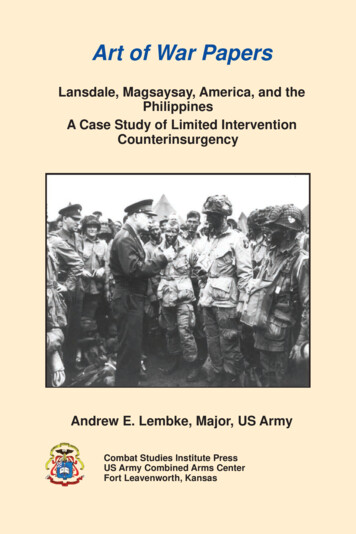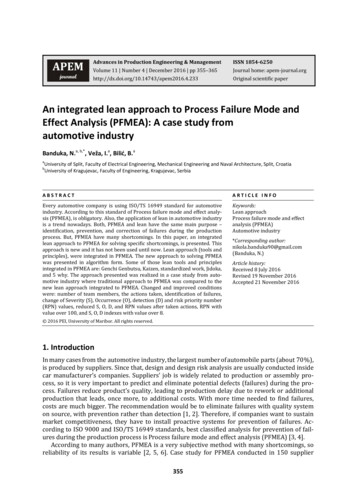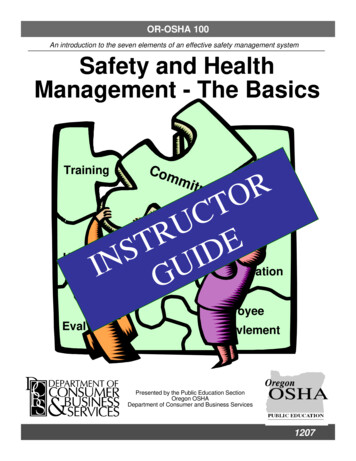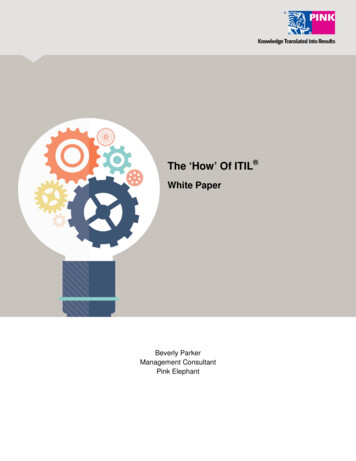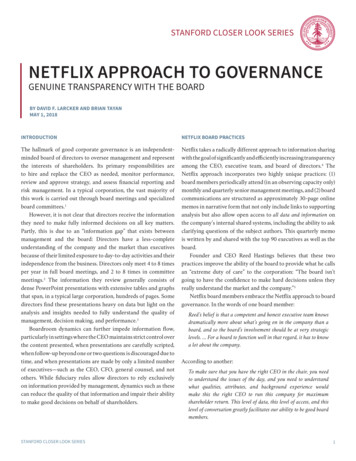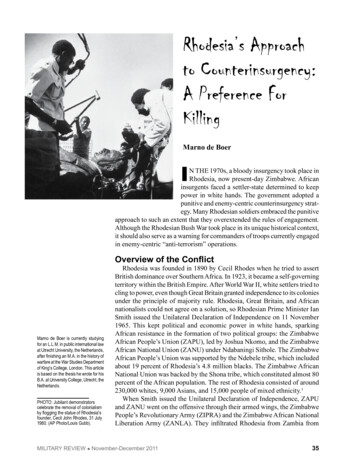
Transcription
Rhodesia’s Approachto Counterinsurgency:A Preference ForKillingMarno de BoerIn the 1970s, a bloody insurgency took place inRhodesia, now present-day Zimbabwe. Africaninsurgents faced a settler-state determined to keeppower in white hands. The government adopted apunitive and enemy-centric counterinsurgency strategy. Many Rhodesian soldiers embraced the punitiveapproach to such an extent that they overextended the rules of engagement.Although the Rhodesian Bush War took place in its unique historical context,it should also serve as a warning for commanders of troops currently engagedin enemy-centric “anti-terrorism” operations.Overview of the ConflictMarno de Boer is currently studyingfor an L.L.M. in public international lawat Utrecht University, the Netherlands,after finishing an M.A. in the history ofwarfare at the War Studies Departmentof King’s College, London. This articleis based on the thesis he wrote for hisB.A. at University College, Utrecht, theNetherlands.PHOTO: Jubilant demonstratorscelebrate the removal of colonialismby flogging the statue of Rhodesia'sfounder, Cecil John Rhodes, 31 July1980. (AP Photo/Louis Gubb).Rhodesia was founded in 1890 by Cecil Rhodes when he tried to assertBritish dominance over Southern Africa. In 1923, it became a self-governingterritory within the British Empire. After World War II, white settlers tried tocling to power, even though Great Britain granted independence to its coloniesunder the principle of majority rule. Rhodesia, Great Britain, and Africannationalists could not agree on a solution, so Rhodesian Prime Minister IanSmith issued the Unilateral Declaration of Independence on 11 November1965. This kept political and economic power in white hands, sparkingAfrican resistance in the formation of two political groups: the ZimbabweAfrican People’s Union (ZAPU), led by Joshua Nkomo, and the ZimbabweAfrican National Union (ZANU) under Ndabaningi Sithole. The ZimbabweAfrican People’s Union was supported by the Ndebele tribe, which includedabout 19 percent of Rhodesia’s 4.8 million blacks. The Zimbabwe AfricanNational Union was backed by the Shona tribe, which constituted almost 80percent of the African population. The rest of Rhodesia consisted of around230,000 whites, 9,000 Asians, and 15,000 people of mixed ethnicity.1When Smith issued the Unilateral Declaration of Independence, ZAPUand ZANU went on the offensive through their armed wings, the ZimbabwePeople’s Revolutionary Army (ZIPRA) and the Zimbabwe African NationalLiberation Army (ZANLA). They infiltrated Rhodesia from Zambia fromMilitary Review November-December 201135
1966 through 1968. Since they did so in largegroups, the Rhodesian security forces quicklydetected and engaged them. By late 1968, thedeath rate was 160 insurgents for 12 security forcemembers. The guerrillas failed to establish a base inRhodesia, and the survivors fled back to Zambia.2After these raids, ZANLA adopted a Maoistapproach, aided by Chinese advisers. It planned toavoid direct confrontations with the security forcesand gradually extend control over the countryside.This changed the pattern of war in the early 1970s,when ZANLA began to establish control over African rural life. Its strategic aim was to overextendthe security forces so that the white economy wouldcollapse as large numbers of reservists were mobilized. An alliance with the Mozambican guerrillagroup FRELIMO permitted ZANLA to infiltrateRhodesia, especially after this group became thelegal government in 1975 following Mozambicanindependence from Portugal.3 ZANLA then floodedRhodesia with guerrillas. In January 1976, therewere an estimated 1,600 present within Rhodesia.By mid-1977, there were 6,000. Near the end ofthe war, ZANLA deployed around 10,000 fightersin Rhodesia while holding 3,500 in reserve abroad.By then, ZIPRA had infiltrated about 4,000 menand held back 16,000 trained fighters.4 Rather thantaking a Maoist approach, ZAPU’s military wingreceived advice and aid from the Soviet Union andhoped for a decisive battle.5In the end, ZANLA’s strategy proved successful.The security forces lost control over large swathsof the country. The increased mobilizations anddefense spending harmed the economy and motivated a significant number of whites to emigrate.By late 1979, Rhodesia was on its last legs.6 Evenan internal settlement in which whites shared powerwith the non-Marxist, African Bishop Muzorewadid not bring peace, because neither the insurgentgroups nor the international community recognizedhis government. In December 1979, Great Britain,Rhodesia, ZANU, and ZAPU reached an agreementin London over majority rule elections. In March1980, ZANU, by then led by Robert Mugabe, wonthe elections.A Punitive StrategyThe Rhodesian security forces embraced apunitive approach to counterinsurgency. Apart from36some attempts at population control, there was noprogram to win over the African population bypositive measures. The army focused on achievinga high “kill rate.”7 It became skilfull at this; evenwith its outdated equipment the Rhodesian Armykilled over 10,000 guerrillas inside Rhodesia andthousands outside it, and it lost only 1,361 servicemembers between December 1972 and December1979. 8 This article illustrates how Rhodesiansoldiers first embraced the kill-rate strategy andsubsequently took it one step further to the extentthat it actually had detrimental effects on the waythe political and military leaders wanted to conductthe war.Existing studies on the background of thispunitive approach explain that its underlyingreason was that the Unilateral Declaration ofIndependence aimed to preserve a privilegedposition for whites. Rhodesians were never willingto give up this position sufficiently to win over theAfricans.9 An approach such as Great Britain usedin Malaya, with improvements to the situation ofthe ethnic Chinese and the promise of Malayanindependence, was therefore not feasible. Whatremained was the use of force to kill insurgents ina strategy of attrition.Ideological blinders reinforced this path. WhiteRhodesians lived under the false impressionthat their country’s blacks were “the happiestin Africa.” 10 They further believed that mostAfricans only understood and respected force.11In that sense, Rhodesia still reasoned the same asBritish Colonel Charles Callwell advised in hislate nineteenth century study of colonial wars.12Moreover, Rhodesians believed that most Africanswere incapable of developing political ideas orforming effective organizations. Therefore, theyreasoned, the war was not the product of domesticinjustices, but of outside communist agitatorsdirected by China and the Soviet Union. The goal ofthe war became to eliminate these “intruders.” Thisinterpretation also fit in with Rhodesia’s reluctanceto share power or resources with blacks.13 In the1960s, the strategy actually worked. The armycould track down and deal with infiltrations thattook place in large groups far from populated areas.This initial success reinforced white Rhodesia’sbelief in its military superiority. Even ZANLA’sturn toward Maoist revolutionary warfare did notNovember-December 2011 Military Review
immediately cause Rhodesiasuch problems that it revisedits strategy. Until FRELIMOtook over in Mozambique,ZANLA could not expandbeyond the underdevelopednortheast of Rhodesia. Thewar then reached a stalemate.14However, from 1976 onward,the punitive approach becamefatal. ZANLA flooded thecountry with guerrillas, whileRhodesia could neither offeran attractive political solutionto the African population norachieve a kill rate higher thanZANLA’s recruitment andinfiltration rates.15(AP Photo/Matt Franjola)BLOODY INSURGENCYGuerrillas who fought a prolonged war rejoice as they leave the stadium whereindependence celebrations were held, Salisbury, Rhodesia, 18 April 1980.Soldiers’ TrainingInfantry training immersed Rhodesian recruitsin the enemy-centric approach. The program aimedat making the recruits adept at killing insurgents.It consisted of six weeks basic training, six weeksconventional warfare training, and five weeksin what we now call counterinsurgency (COIN)training. This last phase trained the recruits inaggressive bush fighting. They learned to snapshootat moving targets with the “double tap” technique(two single shots fired in rapid succession toovercome the recoil of the rifle), lay and reactto ambushes, and disembark from a helicopter.They also learned survival skills.16 In the 1960s,the program had been slightly different, with lessemphasis on COIN, but more emphasis on physicalfitness and weapon skills.17Another goal was to make soldiers aggressivefighters. This took place explicitly in exerciseswhere recruits had to charge at sandbags witha bayonet while swearing.18 One former recruitsuggests that it also took place implicitly over thecourse of the entire training program. Moreover,abusive instructors caused anger and resentmentamong the recruits, which they released on theenemy.19 Some suggest that these same techniqueswere used in American training during the Vietnamera.20Several aspects were notably absent duringbasic training. Most prominently lacking wasMilitary Review November-December 2011training on the treatment of civilians and thevalue of intelligence. The Rhodesian COINmanual did mention the importance of goodcivil-military relations (especially for intelligencegathering), the value of prisoners for intelligencepurposes, and the importance and difficulties ofestablishing observation posts in rural areas.21This is not surprising since contemporary BritishCOIN specialist Sir Robert Thompson wrote thesame. Various high-ranking Rhodesian officershad also fought in the Malayan Emergency fromwhich Thompson drew his lessons.22 The absenceof these themes during basic training is even moreremarkable in the light of how Rhodesia organizedits war effort. Most patrols consisted of a fourman “stick” or an eight-man “call sign,” led by aprivate or corporal. These units had to maintaincivil-military relations, take prisoners, and gatherintelligence on the ground. Despite the importancethe manual attached to these things, soldiers’training focused on the killing part of COIN.Punitive Combat Deployment:Fire Force and External RaidsCombat deployment further strengthened thesoldiers’ enemy-centric experience of war. Thequintessential example of this was the fire force, aRhodesian invention to deploy scarce manpower inan aggressive role. When guerrillas were sighted—usually by the multiracial Selous Scouts dressedas insurgents—Alouettte helicopters and, later,37
results for all the effort and it was felt that something constructive was being achieved.” When itwas quiet, troopers became bored and annoyed witharmy regulations, and morale dropped.26Cross-border raids were the second type ofenemy-centric deployment. When the war escalated, Rhodesia mounted operations into Zambiaand Mozambique to strike at insurgent bases andharass infiltration routes. Initially, the Special AirService, Scouts, and Rhodesian Light Infantry carried out the raids, but later the Rhodesia Regimentsparticipated as well. One reservist even describeda 10-day patrol 70 kilometers into Mozambique.27Soldiers were generally positive about conductingcross-border operations. Just as in fire force duty,operations aimed at a high kill rate and yielded tangible results. Cross-border raids thus correspondedto the Rhodesian perception of the war. Duringcampfire talks, soldiers frequently argued that theyshould strike at foreign bases. They felt frustratedwhen such actions were put on hold for fear of negative reactions from the international community.28Rhodesian Light Infantry troopers also liked thecross-border raids because they confirmed theirstatus as elite soldiers. They heard stories fromthe old guard who had fought with the Portuguese(AP Photo/J. Ross Baughman)Dakota planes flew in troops to box in the enemy.23Initially, white regulars of the Rhodesian LightInfantry manned the fire forces. With the expansionof the war, black soldiers under white officers ofthe Rhodesian African Rifles and white reservists ofthe Rhodesia Regiments also participated. The factthat Rhodesian intelligence attributed 68 percent ofinsurgent deaths inside Rhodesia to the Scouts, whousually let the fire force do the killing, indicates theimportant role of the concept.24The war diary of a Rhodesian African Riflescompany commander, Captain André Dennison,clearly indicates how the fire force changed the soldiers’ experience of war. From 11 July to 22 August1978, his company carried out regular patrols,killing three insurgents and capturing one. Its priordeployment, from 16 May to 27 June, as fire force,resulted in 37 guerrillas killed and four captured.Their next stint as fire force, from 5 September to17 October 1978, yielded 72 killed guerrillas andsix captured.25Fire force troopers possessed the tactical initiative and carried out an aggressive fight against theenemy. This was important because, as one soldierdescribed, “The more contacts there were, thehigher the morale rose, because there were tangibleRhodesian cavalrymen detain a black Rhodesian for questioning, Lupane, Southern Rhodesia, September 1977.38November-December 2011 Military Review
BLOODY INSURGENCYin Mozambique and longed for similar action.Rhodesian Light Infantry troopers felt honored tobe briefed together with the Special Air Service.29Other Internal OperationsWhen not on fire force duty, troops engaged inother tasks that further strengthened their enemycentric understanding of the war. Among these wereambushes and larger sweep operations aimed solelyat killing insurgents. Protection and administrationof protected villages, where peasants were forciblyresettled to isolate insurgents from the population,fell under the responsibility of the separate GuardForce.30 Rhodesian soldiers never engaged in thepacification and development of a specific area.The only internal task not directly aimed at killingwas intelligence gathering. However, this had suchmeager results that it probably did not influencethe soldiers’ perceptions of the war. The earlywarning network of mujibas (teenage insurgentsympathizers) and the white soldiers’ limitedknowledge of the local environment created almostinsurmountable problems.31 Only the Scouts seemto have had the necessary special training and localknowledge to man observation posts effectively.32Dennison’s war diary clearly shows the meagerresults of observation posts and random ambushesof wells and deserted guerrilla camps. Even thoughhis company consisted largely of Africans, thedeployment led to only three insurgents killedand one captured in return for two casualties. Thecontacts that took place were mostly ambushesinitiated by guerrillas. The next deployment, from5 September until 17 October, was again as fireforce, and resulted in 72 killed and 6 captured for4 troops wounded.33 Patrols encountered similarproblems because of the “mujiba” network andunfamiliarity of the region.34 Intelligence gatheringby nonspecialized units was thus not very effectiveand unlikely to change the impression of the war asbeing about killing opponents in aggressive combat.Beer, Boots, and VietnamMore factors than tangible military results influenced the soldiers’ preference for punitive action.The men did not have to spend nights in the coldwhile living off rations. Instead, they slept onstretchers and enjoyed cold beer and freshly prepared food.35 During the day they were on standbyMilitary Review November-December 2011and could play cards rather than walk long distancesas infantrymen. A territorial soldier used to suchfoot patrols was delighted with his deployment ina fire force for precisely these reasons.36Another advantage of fire force was the chance toloot dead guerrillas. A fair number of them carriedmoney, so troopers searched the corpses immediately after a fight. The troopers prized Tokarevpistols, which they could sell for a high price onthe black market.37 They also searched for usefulgear—such as webbing, water bottles, and evenboots—to replace their inferior Rhodesian-issuedmaterial.38The presence of veterans from the VietnamWar further influenced Rhodesian soldiers. Anestimated 1,400 foreigners served in Rhodesiathroughout the war, often with the Rhodesian LightInfantry.39 The number of American or AustralianVietnam veterans in the region is unknown, butmost Rhodesian soldiers seem to have been intouch with at least one at some point.40 Theseveterans had fought a war in which the “bodycount” was seen as the index of success.41 Thiswas essentially the same as the Rhodesian “killrate.” Vietnam veterans were usually well receivedin Rhodesia, and Rhodesian soldiers were ofteninterested in their experiences.42 Most likely, theVietnam veterans strengthened the Rhodesiansoldiers’ punitive focus. Substantiating howinfluential the Vietnam veterans were is difficult,but soldiers’ slang offers a clue. At the beginning ofthe war, insurgents were referred to as “terrorists,”a term that other Rhodesians used throughoutthe war.43 In the late 1970s soldiers began to callinsurgents “gooks.”44 This was the same termsome Americans in Vietnam used to refer to theiropponents.45 One network of infiltration routesfrequently used by ZANLA was also called the“Ho Chi Minh Trail,” after the route used by theNorth Vietnamese to infiltrate the South.46The Punitive Approach One StepFurther: Execution of PrisonersThe soldiers’ preference for killing insurgentsdid not undermine the war effort. The kill ratewas perhaps not a fruitful method to win the war,but Rhodesia’s leaders had designed the kill ratestrategy, so the soldiers’ preference for punitiveaction was execution of the national strategy on the39
tactical level. On the ground, however, the soldiersembraced the punitive approach so wholeheartedlythat it became a goal in itself and harmed plans ofhigher authorities.The frequent execution of surrendering orwounded insurgents is the clearest example ofthis. According to Thompson, gathering intelligence is of paramount importance in counterinsurgency. It allows security forces to eliminatethe insurgent underground network and achievea high kill rate. The main sources of informationare agents, informers, and captured opponents anddocuments.47 In 1960s’ Rhodesia, it was indeed theinformer network of Police Special Branch thatdetected most infiltrating guerrillas.48 However, by1972, ZANLA had politicized the population anddestroyed the informer network in northeasternRhodesia.49 Breathing new life into this networkwhile at war proved difficult.50As a result, taking prisoners became vital to thewar effort. Together with captured documents, itwas the first way of obtaining intelligence. Thefact that the insurgents often talked after capturehelped the British in Malaya.51 This seems to havealso been the case in Rhodesia.52 The informationextracted from prisoners was indeed vital for planning attacks on insurgent camps.53 The problemwith prisoners and documents was that they onlyrevealed old information. To gather fresher intelligence that could lead to killing insurgents insideRhodesia, the army founded the Selous Scouts in1974. They posed as insurgents to obtain information from villagers on the guerrilla presence andreconnoiter without “mujibas” raising the alarm.Then they captured the insurgents themselves orcalled in a fire force. To function, the pseudoconcept required a constant flow of informationon insurgent habits, watchwords, training, andorganization.54 Prisoners thus became vital to theRhodesian intelligence effort.However, ordinary Rhodesian soldiers oftenexecuted wounded or surrendering guerrillas. TheRhodesian Light Infantry and African Rifles weremainly involved in this, because as fire forcesthey had the most contacts. In the RhodesianLight Infantry, the execution of wounded enemywas almost standard operating procedure. DennisCroukamp, who served in the Light Infantrybefore and after a stint with the Scouts, says that40Light Infantry platoon commanders usually shotwounded or surrendering guerrillas. Most of themknew that people higher up needed and wantedprisoners, but they simply chose to ignore this.55Prisoner execution took place in other units aswell. In 45 months, Dennison’s African Rifles Company killed 364 insurgents and captured only 39.56The most likely explanation for this discrepancyis that the men were not inclined to take prisoners.That insurgents took their wounded with them aftera fight is an unlikely explanation. Their favoritecountermeasure against fire forces was to run off inall directions.57 Moreover, the number of weaponscaptured usually coincided roughly with the numberof kills and captives.58 Guerrillas likely did not takeanything but their own gear when fleeing becausethe fire force shot the wounded. A reservist alsomentioned how a captain encouraged the executionof prisoners.59Apart from personal consideration, there weresome general motives behind all this. Althoughracism undoubtedly played a role, a strongideological commitment to the Rhodesian causewas not a precondition. Some of the RhodesianLight Infantry troopers cited above were not strongideological supporters of the Rhodesian cause.60This was even clearer in the case of the AfricanRifles soldiers who were in the army mostly forthe economic opportunity. Nevertheless, it islikely that the general framework through whichRhodesians perceived the war paved the ground forthe executions. In their eyes, the enemy consisted of“communist terrorists” from abroad who infiltratedpeaceful Rhodesia, home of the “happiest blacksin Africa.” Shooting someone thought of as a“terrorist” was probably easier for troopers thanshooting a peasant disaffected with Rhodesia’sracial and social inequities. Training, with itsfocus on aggressive bush fighting, reinforced thisframework.The intensification of the war hardened theseattitudes. In the late 1960s and early 1970s,Rhodesian Light Infantry troopers had accompaniedthe Portuguese Army in Mozambique. One ofthese men mentioned how the Portuguese habit ofexecuting prisoners shocked the Rhodesians, butlater they did exactly the same.61 Another soldier,when complaining about an order to give first aidto wounded guerrillas, said his sergeant probablyNovember-December 2011 Military Review
BLOODY INSURGENCY(AP Photo/Zuheir Saade)did not know yet how dirty the war was, and thattheir opponents would never consider treating awounded Rhodesian soldier.62 Given the fact thatthe opinion of Rhodesian society hardened as welltoward the end of the war, it is likely that manyreservists experienced feelings similar to those ofthe regulars.63Another reason for executing prisoners rather thanholding them captive was the low regard Rhodesiansoldiers had of the intelligence community.Special Branch was in many ways a peacetimepolice organization that had trouble providing theoperational intelligence the army needed.64 LettingSpecial Branch handle intelligence had worked wellfor the British in Malaya, but it exchanged qualifiedliaison officers with the army.65 In Rhodesia, thearmy often used the few existing intelligenceposts to get rid of incompetent officers.66 Onlywhen individuals of both organizations cooperatedclosely on a permanent basis, such as in the Scouts,Zimbabwe Prime Minister Robert Mugabe speaks duringa press conference at Bintumani Hotel, Freetown, SierraLeone, 4 July 1980.Military Review November-December 2011did the situation improve.67 Croukamp rated theintelligence he received with the Scouts muchhigher than intelligence he received with theRhodesian Light Infantry. Other soldiers expresseda similar opinion.68 Apart from the merits of SpecialBranch, it seems that the lack of emphasis onintelligence during training also contributed to thisreluctance to comply with intelligence requests.Another reason for the executions was a practicalone. Captives, wounded or not, could still escape orresist, so the troopers had to guard them. Since theRhodesians fought in four-man sticks, it was hardlypossible to leave someone behind as a guard. Aftercontact, troopers had to carry wounded prisonersto a suitable helicopter-landing zone, making thestick vulnerable to ambushes. Troopers often foundit easier to execute a prisoner. Prisoners took upvaluable space in the Alouette, which could onlytransport four men. This would mean that thetroopers had to stay out overnight rather than enjoya cold beer at the base.69Toward the end of the war, with the internalsettlement in sight, and even more so when theLancaster House talks started, soldiers realizedthat prisoners might gain their release underamnesty programs. Consequently, some killedsurrendering guerrillas in the field and held captiveonly an officer who could reveal the most valuableintelligence.70 This execution of prisoners at thetime of the amnesty program was not only harmfulto intelligence gathering, but also hampered thepolitical solution Rhodesia tried to achieve withthe backing of black prime minister Muzorewa.Rhodesia hoped that Muzorewa would makeAfricans acquiesce in a society in which thewhites retained a privileged position and convincethe international community to lift the sanctionsimposed after the Unilateral Declaration ofIndependence. One of the main ways to show thatMuzorewa had genuine popular support and couldend the war was an amnesty program to create agovernment militia of former guerrillas. Eitherbecause Muzorewa did not appeal to the rebels orbecause of the strict control these organizationsenforced over their members, the scheme’simplementation was problematic. 71 Capturedinsurgents, fully under government control, wouldhave been an ideal recruitment pool. The frequentexecutions by the men on the ground prevented this.41
Violence Toward CiviliansViolence against civilians also supports thethesis that soldiers adopted and extended thepunitive approach to counterinsurgency. About19,000 African civilians died in the war. Partlythis was a result of insurgent actions. They usedforce against uncooperative civilians, used them ascover, and targeted the rural health and veterinaryservices. This later caused a surge of malaria,rabies, and tsetse flies. As the war intensified, thegovernment allowed more violence against blackcivilians. This punitive approach had started in1973 with the imposition of fines on communitiesthat aided insurgents. Brutalities against civilianswere not yet accepted, but in the late 1970sRhodesia used the term “killed in crossfire” ratherliberally.72 There was never a clear and uniformpolicy targeting civilians though. Actually, thecabinet always pushed for a tougher approach,while General Walls, Rhodesia’s most seniormilitary official, tried to limit the freedom IanSmith wanted to give him. At one point Smith,supported by several cabinet members, evenproposed to abandon the “Queensbury Rules ofwaging warfare” and impose nationwide martiallaw. Walls retorted that if the cabinet really wantedthat, it should resign and let him rule the countryat the head of a military junta.73In this climate, soldiers had greater freedomto stretch the rules. The reporting of a significantnumber of “killed in crossfire” was now accepted,while in the early 1970s Special Branch still treatedeach death as regular police work.74 One soldierprobably described the new attitude accurately: “Ifin doubt, shoot. It kept you alive.” He, for example,opened fire on a hut if he saw an insurgent hidingamidst civilians. Soldiers also disclosed that theyshot at unidentified figures running at a distance.75Dennison’s war diary gives some idea of thenumber of civilians killed this way. Between 29November 1975 and 28 July 1979, his companykilled 364 insurgents and captured 39 while killing170 civilians (the number of wounded civilians isnot recorded).76Interestingly enough, soldiers did notconsciously execute government policy when theytargeted civilians. The above-mentioned soldierwho shot to stay alive thought that higher-rankingofficers tried to adhere to the Geneva Conventions42while “the troops in the field tended to sneer at theidea.”77 Another soldier explained how troops beatup uncooperative civilians to extract information.Such treatment was actually illegal, and usuallyineffective, but often happened.78 An instructoralso told Rhodesian Light Infantry recruits thatif a civilian saw him on a cross-border operation,he would kill the person so there was less riskof compromising the mission. He would neverdo this in Rhodesia, because there, “the Ruleof Law applied.” 79 Given this notion amongsoldiers that the killing of civilians was illegal,we cannot explain the large number of personskilled in crossfires as government policy. It wasprobably another manifestation of Rhodesiansoldiers embracing a punitive approach towardcounterinsurgency and taking it one step furtherthan (they thought) was allowed, by showing littleregard for civilian lives.Attempts to Wreck the PeaceSome soldiers embraced the punitive approachso enthusiastically that they wanted to fight onafter Mugabe’s electoral victory. Initially, therewas “Operation Quartz,” a counter-coup designedby the higher echelon of the security forces in caseMugabe lost the election and decided to resumethe war. With South African support, the air force,Special Air Service, Selous Scouts, and RhodesianLight Infantry would take out ZANU’s leadersand the guerrillas at the ceasefire assembly points.This was supposed to set back ZANLA’s war effort20 years, after which ZAPU would be invited tojoin a coalition government. Many junior officersand NCOs who knew of the plan either hoped orwanted it to be a preemptive coup. This did nothappen because both Muzorewa and General Wallsrefused to lend their support to it when the firstnews of Mugabe’s victory surfaced. Rhodesia’sleaders knew that the game was up.80Nevertheless, some soldiers were so d
Dec 31, 2011 · egy. Many Rhodesian soldiers embraced the punitive approach to such an extent that they overextended the rules of engagement. Although the Rhodesian Bush War took place in its unique historical context, it should also serve as a warning for commanders of troops curren
